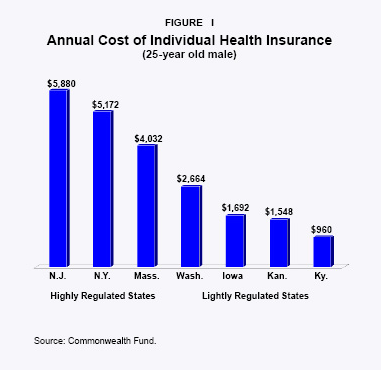Rep. John Shadegg (R-Ariz.) has introduced the Health Care Choice Act (H.R. 2355), which would increase access to individual health coverage by allowing insurers licensed to sell policies in one state to offer them to residents of any other state. Sen. Jim DeMint (R-S.C.) has introduced a companion bill in the Senate (S. 1015). If enacted, the law would create a more competitive, nationwide health insurance market.

Most Americans receive health coverage through employer-sponsored plans. However, nearly 17 million people currently purchase insurance for themselves and their families in state-regulated individual insurance markets. Another 46 million people are uninsured at least some portion of each year. High costs prevent some of the uninsured from purchasing individual coverage; thus, lower prices could potentially affect a large number of people.
The Cost of Health Insurance Varies Widely. The cost of individual health insurance varies widely from state to state. The Commonwealth Fund and e-HealthInsurance.com compared the prices of policies in seven states with varying degrees of regulation. The policies had similar coverage and a deductible of about $500. As Figure I shows:
- A 25-year old male in good health could purchase a policy for $960 a year in Kentucky. That policy would cost about $5,880 in New Jersey.
- A similar policy available in Kansas for about $1,548 costs $5,172 in New York State.
- A policy priced at $1,692 in Iowa and $2,664 in Washington State would cost $4,032 in Massachusetts.
The difference in premiums is mainly due to state regulations rather than variation in health care costs.
Many State Markets Are Not Competitive. In competitive markets, producers seek to reduce costs and to offer products that meet customer demands. However, the United States does not have a competitive national market for individual health insurance. Firms in each state are protected from interstate competition by the federal McCarran-Ferguson Act (1945), which grants states the right to regulate health plans within their borders. (Large employers who self-insure are exempt from these state regulations.) Thus there is a patchwork of 50 different sets of state regulations, and the cost for an insurer licensed in one state to enter another state market is often high. As a result, consumers have little choice among plans. In many localities, only one insurance product is available, so the consumer is forced to buy an overpriced product, or forgo insurance altogether.

The Commonwealth Fund found that the market for individual health insurance is highly concentrated in the states studied. The largest carrier in all seven is Blue Cross Blue Shield, with 60 percent of the individual health insurance market in New Jersey, Iowa and Kansas, 70 percent in Massachusetts and 90 percent in Kentucky.[See Figure II.]
Lack of Competition Drives Expensive Mandates. Since each state insurance market is protected from interstate competition, legislators can require insurers to cover services that drive up premiums. For example, about one-fourth of states mandate benefit packages that cover acupuncture and marriage counseling. More than half require coverage for social workers and 60 percent for contraceptives. Seven states require coverage for hairpieces and nine, hearing aids.
Proponents often claim a given mandate costs very little – but they add up. There are approximately 1,843 state mandates, according to the Council for Affordable Health Insurance, an industry trade group. Some estimates suggest these mandates have priced as many as one-quarter of the uninsured out of the market.
Two other insurance regulations that raise costs are guaranteed issue and community rating.
Guaranteed issue means that any insurance company offering policies must sell coverage to all applicants who qualify, regardless of medical condition. While this sounds like it protects consumers, it actually harms them by driving up prices. When insurance companies are forced to accept all applicants, they raise premiums to guard against losses. As a result, insurance is a poor value for everyone except those with serious health conditions, and people often wait until they become sick to buy it. Subsequently, business dwindles, insurers leave the market and rates go up as competition diminishes. This has happened in all states that require guaranteed issue.
Community rating means that an insurer cannot adjust its premiums to reflect the individual health risk of consumers. While this regulation achieves a level premium for everyone, in reality, healthy people are charged more than they otherwise would be and sick people are charged less. Therefore, the majority who are healthy see their premiums rise. As Figure I shows, a plan for a healthy 25-year old male costs six times more in New Jersey than in Kentucky, largely due to community rating. Because of the higher cost, younger (or low-income) individuals with few health problems tend to drop insurance, leaving an increasingly unhealthy risk pool. This drives premiums ever higher – and fewer and fewer people can afford coverage.
Reforms Are Needed. The Health Care Choice Act would allow consumers to shop for individual insurance on the Internet, over the telephone or through a local agent. Residents of any state would be free to choose among policies from any insurer that offers them. The policies would be regulated by the insurer's home state. Thus, if consumers do not want expensive "Cadillac" health plans that pay for acupuncture, fertility treatments or hairpieces, they could buy from insurers in states that do not mandate such benefits. Consumers would be more likely to find a policy that fits their budget – giving more people access to affordable insurance.
Devon M. Herrick is a senior fellow with the National Center for Policy Analysis.